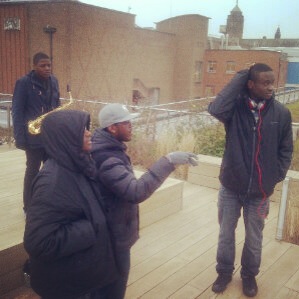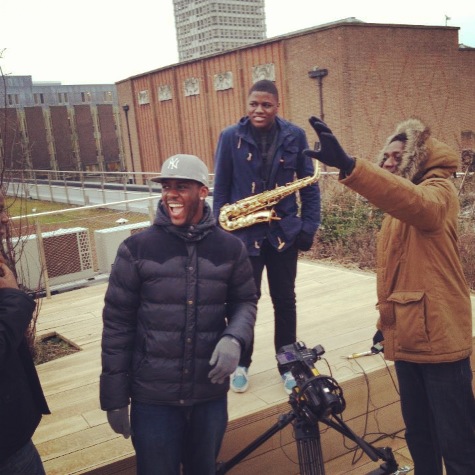A documentary about musician Joseph Oyelade created by Adewale Shittu, Jean Luc Tanguy Bampoye and I.
Archive for March, 2013
Overall I think we strived in the creative aspect of project. We experimented with different shot types on the shoot and using different colors, effects to accentuate the message we was trying to tell visually with every frame. We didn’t want it to be just a sit-down interview, but in three minutes it is easy just to take that format and use because of the time relation. Everyone in my group was fully involved in everything. We all had creative ideas, all set up the equipment and all did some sort of research into music documentaries.
The finished product does match up to the codes & conventions of documentary films about musicians. Choosing two prominent locations is us, collectively, not limiting ourselves creatively. The sound in the final product was difficult to work with because of the instruments used so the audio levels are a bit strange in places in the documentary. As far as capturing Joseph’s emotion in relating to how he feels towards/about making music and the craft involved and how he touches people, we used the music he played live for us to emphasize this emotion. I am very happy with how the final product.
We had no problems setting up the equipment; my group and I were very acquainted with the equipment we were using. We specifically used clip on microphones to capture the sound of the saxophone because it was logical to use any other microphone because they would be an eyesore to the shot. We shot over two days because we had booked the music recording room on Monday and we contacted the Manager of the Hub for permission to shoot on the roof for Tuesday.
Personally, I think the shoot went very well. We got lots of different shots, we got more than what we needed which is always a good thing, this meant in post-production we had more creative freedom. We also booked out a Dolly so the camera was mobile so we could move it around while filming. However, this did have its problems because of the uneven floor in the music room the camera kept shaking as we moved it. Another problem we encountered was the lack of lighting in the music room and on the day of our first shoot no Dedolights were available so we had to use Redhead lights and focus one light on the floor and one into the corner of the room. 

My group and I decided to watch a few music documentaries about a few musicians we all know, most notable being Kendrick Lamar and Giggs (UK Rapper). Our musician isn’t a rapper, he composes music and plays musical instruments rather than song write and perform the lyrics in rap form. We also learned a lot about the pace of the documentary, the pace had to be slower than average because of the pace of the music. We decided to have him play different musical pieces that are of slow tempo to create an sincere atmosphere around the words he speaks and how he answers questions.
We also wanted a standout shot of our subject, in a location that was quiet and serene to match the type of music he plays. So we decided to contact the Supervisor of The Hub to ask if we could film on The Hub’s roof terrace. Up there it is quiet and it has a nice backdrop of Coventry Cathedral that adds visual quality to the shot.
For a shot we wanted to include in the documentary we had to practice it before filming it on the shoot. We wanted to double our subject so there was two of him in one shot. This technique would be achieved in post-production
I decided to adapt my short film to the editing style of ‘French New Wave’, so I decided to watch ‘Tiré sur le pianiste’ (Shoot the piano player). The film was directed by François Truffaut and was released on 26th November 1960. François Truffaut was and is considered to be one of the pioneers of the French New Wave movement that was influenced by Italian Neorealism and Alfred Hitchcock movies. The French New Wave film movement was sparked by several French film critics’ annoyance with French Cinema’s “Tradition OF Quality”. French New Wave filmmakers focused on social matters at the time of making them films rather than the big Classical Hollywood narrative. As the phrase “New Wave” implies, the French New Wave cinematic movement was a “New Wave” of thinking, filming and editing techniques in French Cinema.
Titles
When I started watching Shoot the piano player I instantly noticed that obviously it was in black and white, then I paid more attention to the Font used in the opening titles so I downloaded several fonts from www.DaFont.com and experimented with a few. But, after watching parts of Jean-Luc Godard’s Á bout de soufflé (Breathless, 1960) I chose a font named ‘Frenchy’ and stuck with it. During Shoot the piano player I also noticed that there are rarely any extra titles used to pass on information to the audience, there is only one other title used in the film other than the opening credits. This is why I decided to only use one title in my film which is necessary as it was in Shoot the piano player as it informed the audience of how much time had passed between the sequences, thus linking the movie together so it makes sense.
Sequences
The sequences in Shoot the piano player are abnormally long; this is reflective of the French New Wave film-style. There are also quite a few short intermissions from the main narrative arc to delve into the mind of Charlie Kohler/Edoaurd Saroyan, the lead character. This gives the audience a chance to feel what he’s feeling and understand the narrative from his perspective, thus giving him emotional leverage over other characters, the audience are more inclined to feel sorry for him because they feel much more closer to him than anyone else. This is an extended voice-over, which is typical of French new Wave films. Unfortunately, there are no sequences of this kind in my short film because they weren’t written into the script, but if I had time I would add one sequence where our main character ‘Jeremy’s mind is put on blast and the audience get to hear his thoughts.
Transitions
Different from normal Hollywood, the transitions in Shoot the piano player vary and are always used to represent the passing of time. The Iris Wipe that was first seen and utilized in Silent Movies is used in Shoot the piano player just before the second bedroom sequence after the café sequence. I think this is used to show a longer amount of time that has passed compared to the dips to black that are used which are used to show a shorter period of time which has passed. Cross-Fades were used in the film to represent what a character visualised in their mind and was mixed into what they were saying, this is present in the second bedroom sequence. Jump-cuts are also used to show an abrupt change in a characters movement and speed up a sequence for effect e.g. if a character is in a chase of some sort, jump-cuts can be used to dramatize the sequence by quickening up the pace of. Jump-Cuts are not and were not convention in Classical Hollywood because it ruins the continuity of a film and continuity editing is the style of editing which is used in Classical Hollywood films. I used Jump-Cuts to quicken up the pace of the sequence where ‘Jeremy’ is seen walking through various corridors to leave the University building, this helped to create the effect that he was being chased, because he was, by ‘Sophie’, an ex-girlfriend who killed herself and is now haunting him because she left. I also used Jump-Cuts to make ‘Sophie’ seem supernatural in relation with her movements.
Sound
Most if not all of the sound used in Shoot the piano player is Diegetic sound, hardly any Non-Diegetic sound is used in the film. The film is centered around a Pianist so most of the time the ‘mood music’ used is there to be seen as if it is coming from the instrument Charlie Kholer or any other person plays in the film, making the sound Diegetic as we know where it is coming from. However, there are a couple times where the ‘mood music’ is Non-Diegetic. In my edit of my groups short film there was no instrument present and any instrument included in the visuals would not be relative to the narrative so the music I used is Non-Diegetic. The music is from Jean-Luc Godard’s Breathless. I edited ad cut out certain parts of the music to try and set the tone/mood in relation to what is shown on screen. Other than the music I used I did not use any other Non-Diegetic sound.
My Film
I think my film utilizes the codes and conventions of the “French New Wave” film style, I have adapted the narrative so the conventions work in the film. I especially like the music which helps set the mood for the series of shots in the film and the jump cuts which I used to create a feeling of danger in the form of some sort of chase.
